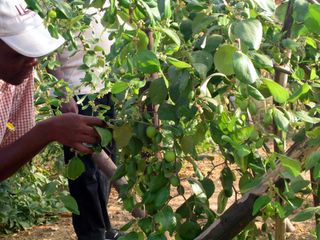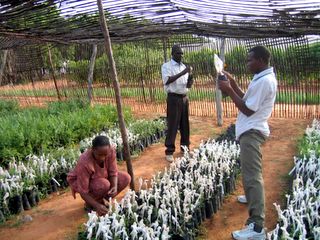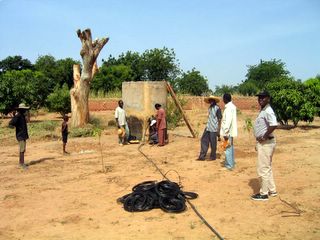|
||||
Jump-Starting High Value Tree Crops in KenyaA groundbreaking joint program of ICRISAT and the International Program for Arid Lands Crops (IPALAC) has for the past few years been developing higher-value crops and cropping systems to help alleviate dryland poverty while enriching food supply channels to urban and export markets. To absorb these innovative approaches, a team of four Kenyan researchers working with the DMP was sent for training to ICRISAT-Niamey during September-October 2004. Kenya's interest was particularly stimulated by observations of station demonstrations at ICRISAT-Niamey showing that certain crops and particularly trees and indigenous fruits can realize much higher potential by grafting the branches of improved varieties (scions) from elsewhere onto the rootstocks of locally-adapted species. A Ber market in Niger The four staff identified over 15 trees/technologies for up-scaling in Kenya. Kenya was particularly interested in the abundance in arid lands of the unimproved indigenous fruit genus Zizyphus. Zizyphus mauriritania in particular has been revolutionized through the grafting of improved varieties from India and Pakistan which are of near-commercial quality, known locally as 'Ber' fruit. In Rajasthan State, India, in the region of 600 mm annual rainfall, one hectare of Zizyphus mauriritania planted at a density of 10x10 m gives an annual fruit yield of 10,000 kg, an annual yield of leaves for forage of 9,000 kg, and an annual yield of wood of 6,000 kg.
In Kenya, Zizyphus is widely distributed, growing in areas with from 250 to over 800 mm of rainfall. Mother plants of Zizyphus are now being established in all the three Kenya DMP sites in anticipation of the arrival of scions from ICRISAT-IPALAC, Niger. Objectives of the training
Topics covered during the training
Practical exercises in the field introduced the trainees to important shrubs/trees for arid lands. Some of these are improved Zizyphus spp. (varieties include Katley, Ben Gurion, Gola, Seb and Umran) Acacia senegal (gum arabic), date palm, Hibiscus spp., Cassia sena, Tamarix spp., Ficus carica, Japtropha curcas, Moringa oleifera, Lannea microcarpa, bamboo, Saba senegalensis and Lawsonia inermis (henna). Important fruit trees encountered included different varieties of mangoes, oranges, guavas, pomegranates, Achras sapota, Annona spp., grapes, papaya and Tamarindus indica (the sweet variety). Spillover benefits of the visit included lectures on the local livestock breeds and traditional water harvesting technologies.
Return to On the Edge table of contents
|
||||
|

 Ber
fruit is much in demand in Niger. The improved variety is more
nutritious than apple. It has much bigger fruit than the wild
Zizyphus mauriritania, and much larger leaves. It is pruned at
the beginning of the rainy season to encourage flowering. The photo
(left) shows an improved Zizyphus with large fruit being
admired by the trainees.
Ber
fruit is much in demand in Niger. The improved variety is more
nutritious than apple. It has much bigger fruit than the wild
Zizyphus mauriritania, and much larger leaves. It is pruned at
the beginning of the rainy season to encourage flowering. The photo
(left) shows an improved Zizyphus with large fruit being
admired by the trainees.
 Theory
and practicals on the installation of the African Market Garden
(photo at left, installing low-cost drip irrigation) and the
Sahelian Eco-farm systems, and the principles behind them
Theory
and practicals on the installation of the African Market Garden
(photo at left, installing low-cost drip irrigation) and the
Sahelian Eco-farm systems, and the principles behind them